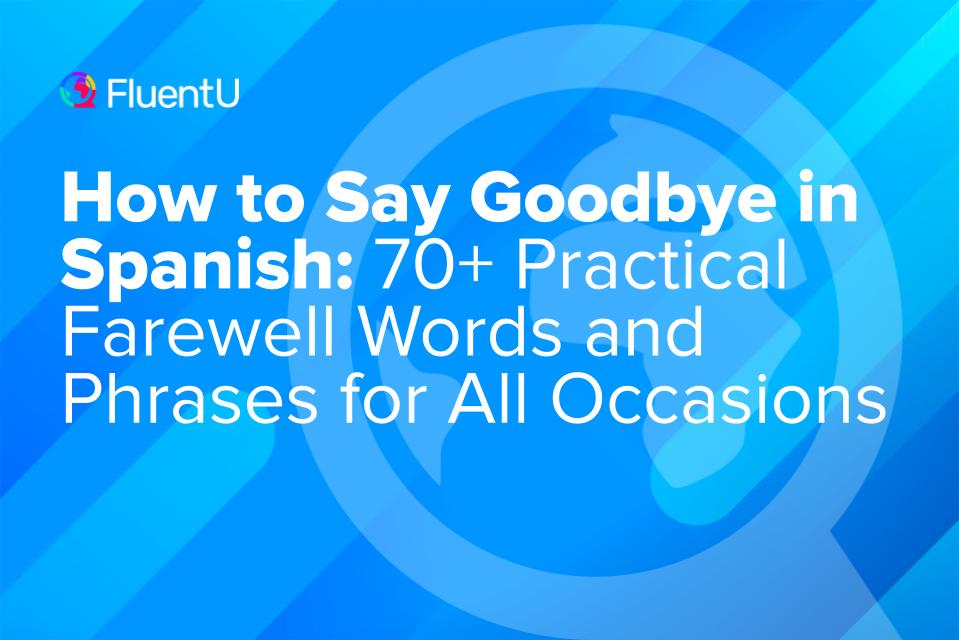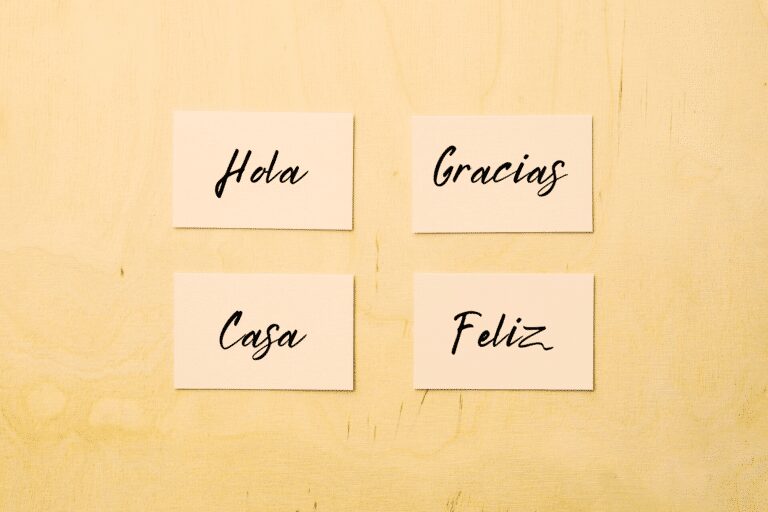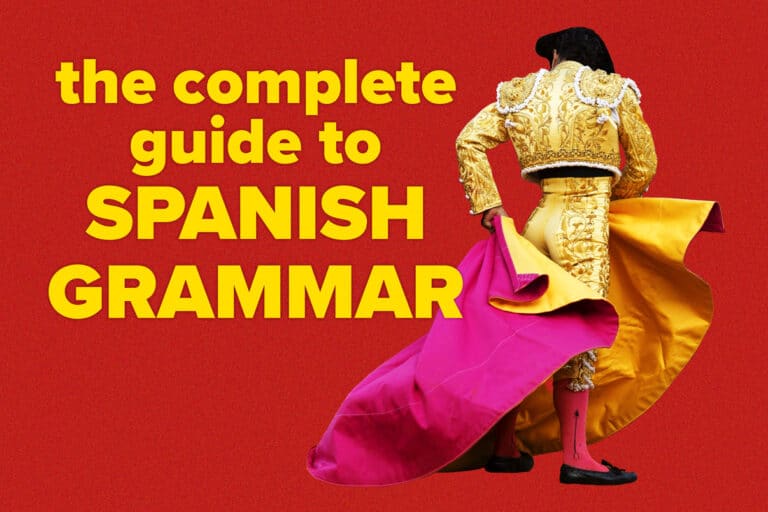Contents
- Most Common Ways to Say Goodbye in Spanish
- Adiós — Goodbye
- Hasta luego — See you later
- Hasta mañana — See you tomorrow
- Hasta pronto — See you soon
- Hasta la próxima — Until next time
- Hasta… — Until…
- Te veo — See you
- Nos vemos — See you
- Nos vemos por ahí — See you around
- Encantado / Encantada — Pleased to meet you
- Cuídese — Take care
- Diviértase — Have fun
- Que tenga un buen día — Have a good day
- Formal Goodbyes in Spanish
- Casual Goodbyes in Spanish
- Slang and Colloquial Goodbyes in Spanish
- Goodbye in Different Spanish-speaking Countries
- Saying Goodbye in Different Situations
- Resources to Practice Saying Goodbye in Spanish
- And One More Thing…
How to Say Goodbye in Spanish: 70+ Practical Farewell Words and Phrases for All Occasions

“Goodbye” is one of those basic phrases that you just have to know in any language you speak.
And there are many ways to bid farewell in Spanish.
Whether you want a formal “take care” or a more casual “see you later,” this list has got you covered.
So don’t say bye just yet!
Read on for 70 ways to say goodbye in Spanish and when to use each one.
Download: This blog post is available as a convenient and portable PDF that you can take anywhere. Click here to get a copy. (Download)
Most Common Ways to Say Goodbye in Spanish

You’ll notice a common theme among many ways to say goodbye in Spanish.
Adiós — Goodbye
Adiós should be your basic go-to word whenever you’re not sure how to appropriately say goodbye.
That’s because it’s incredibly common and can be used formally or informally.
It’s also the closing you’d use when an absence is long-term or permanent. It’s the Spanish word that most literally translates to “goodbye.”
Adiós, nos vemos mañana. (Goodbye, see you tomorrow.)
Hasta luego — See you later
Hasta luego is an informal phrase that literally means “until then.”
It’s used like “see you later” is used in English, but it isn’t literal. That is, you can use it even if you don’t plan to see the person in the near future.
Gracias por la reunión. Hasta luego. (Thank you for the meeting. See you later.)
This phrase is very common, so it’s one you’re likely to hear often.
It’s also a pretty good song—there’s just something appealing in singing about goodbyes!
Hasta mañana — See you tomorrow
This is another informal phrase that literally means “until tomorrow.”
It’s used to mean “see you tomorrow,” and is something you’d say to a coworker or someone else you’ll probably see the next day.
Gracias por tu ayuda hoy. Hasta mañana. (Thank you for your help today. See you tomorrow.)
Hasta pronto — See you soon
Hasta pronto is an informal phrase that literally translates to “until soon.” It’s like saying “see you soon” in English.
Unlike hasta luego, though, it’s usually used when you’ll actually see someone soon.
Me encantó la comida. Espero verte de nuevo. ¡Hasta pronto! (I loved the food. I hope to see you again. See you soon!)
Hasta la próxima — Until next time
This informal phrase literally translates as “until the next one.”
Use it to mean “until next time,” like when you’re saying goodbye to your weekly trivia team, parting ways after your kid’s PTA meeting or in any other situation where you’d see the same people again in a similar setting.
Fue genial pasar tiempo contigo. Hasta la próxima reunión. (It was great spending time with you. Until the next meeting.)
Hasta… — Until…
Yes, you can make your own informal Spanish closing! All you have to do is fill in the blank after hasta with the next time you plan to see someone.
For instance, at a regular weekend event, you might depart from your friends by saying:
Hasta el próximo sábado. (Until next Saturday.)
Te veo — See you
Te veo is an informal phrase that literally translates to “I see you.”
However, its actual meaning is decidedly less creepy: it comes across similarly to “see you” or “see ya.”
You can also pair it with when you’ll see the person next. For instance, you might say, “te veo mañana” (see you tomorrow).
Mañana nos encontramos en el parque. Te veo entonces. (Tomorrow we’ll meet at the park. I’ll see you then.)
Nos vemos — See you
Nos vemos literally means “we see each other,” as in “we’ll see each other,” but it’s also used to mean “see ya.”
Gracias por la cena. Nos vemos el próximo fin de semana. (Thank you for dinner. We’ll see each other next weekend.)
Nos vemos por ahí — See you around
Use nos vemos por ahí if you don’t know exactly when you’ll see each other again.
And again, this way to say “see you around” is very informal!
Estoy deseando volver a coincidir. Nos vemos por ahí. (I’m looking forward to running into you again. See you around.)
Encantado / Encantada — Pleased to meet you
This one literally means “enchanted.”
It’s often said just after being introduced, but it can also be used again as you part ways with this new person to tell them “pleased to meet you!”
Encantada de conoceros, chicos. ¡Buenas noches! (Nice to meet you guys, good night!)
Cuídese — Take care
Informal: Cuídate
This means “take care” and has slightly different forms depending on the formality: Cuídese is formal, while cuídate is informal.
Gracias por su ayuda. Cuídese. (Thank you for your help. Take care.)
Diviértase — Have fun
Informal: Diviértete
Diviértase is in the affirmative imperative form, so you’re not just telling someone to “have fun!”—it’s a command!
¡Nos vemos más tarde en la playa! Diviértete. (See you later at the beach! Have fun.)
Que tenga un buen día — Have a good day
Informal: Que tengas un buen día
This simply means “have a good day.”
Like cuídese/cuídate, this phrase can be used formally or informally with minor modifications: que tenga un buen día is formal, while que tengas un buen día is informal.
Note the minor but crucial difference in conjugation!
Le agradezco por su ayuda. Que tenga un buen día. (I appreciate your help. Have a good day.)
Formal Goodbyes in Spanish

Le saludo atentamente — I send you my respectful regards
This is a very formal closing phrase, often used in written correspondence. It can be translated to “I send you my respectful regards.”
Agradezco mucho su colaboración en este asunto. Le saludo atentamente. (I greatly appreciate your cooperation in this matter. I send you my respectful regards.)
Que le vaya bien — May it go well for you
This is similar to saying “May it go well for you” in English, which is a courteous way to say goodbye.
Le agradezco por su tiempo. Que le vaya bien en sus proyectos. (I thank you for your time. I hope everything goes well for you in your projects.)
Me despido — I bid you farewell
Ha sido un placer hablar contigo. Me despido. (It has been a pleasure talking with you. I bid you farewell.)
Con permiso — Excuse me
Con permiso. Tengo otra reunión. (Excuse me. I have another meeting.)
Excelente día — Have an excellent day
Gracias por su ayuda. ¡Excelente día! (Thank you for your help. Have an excellent day!)
Quedo a su disposición para cualquier cosa — I remain at your disposal for anything
Si necesita alguna otra información, quedo a su disposición para cualquier cosa. (If you need any further information, I am at your disposal for anything.)
Casual Goodbyes in Spanish

Me voy — I’m going, I’m leaving
Me voy literally translates to “I’m going,” so it should come as no surprise that this is an informal way to say goodbye. I’m going… away!
Gracias por la visita, pero me voy. (Thank you for the visit, but I’m leaving.)
Chau / Chao — Bye
This is a very informal, colloquial way to say “bye.”
It’s likely derived from the Italian ciao, but unlike its Italian cousin, it’s usually only used between friends or in informal situations.
Ya me voy, chau. Nos vemos mañana. (I’m leaving now, bye. See you tomorrow.)
Bye
It may not be exotic. It may not be intriguing. It may not even really be Spanish.
But the fact of the matter is, bye is sometimes used as a colloquial, informal closing in Latin America.
So, there’s no need to have your hearing checked—that native Spanish speaker might actually have used this word as you parted ways!
Gracias por la cena. Bye. (Thanks for dinner. Bye.)
Hasta la vista — Until we see each other again
This informal closing literally means “until the view,” but it’s interpreted more as “until we see each other again.”
Fue un placer conocerte. Hasta la vista. (It was a pleasure meeting you. Until we meet again.)
It’s hard to separate this one from its pop culture reputation, and we can’t deny that it’s tempting to say it with an Austrian accent, baby.
Nos vemos luego — We’ll see each other later
This is an extended version of “Nos vemos” and means “We’ll see each other later.”
Gracias por la ayuda. Nos vemos luego en la oficina. (Thank you for the help. See you later at the office.)
Adiosito — Bye
This is a diminutive form of adiós which adds a friendly and informal tone.
Adiosito, espero verte pronto. (Goodbye, I hope to see you soon.)
Chauito — Bye
Another diminutive form of “chao,” giving it a more informal and affectionate feel.
Chauito, mi hija. (Bye, my daughter.)
Slang and Colloquial Goodbyes in Spanish

Nos vemos al ratón — See you later
This is a playful way of saying “see you later,” which literally means “see you later to the mouse.”
Me tengo que ir. ¡Nos vemos al ratón! (I have to go. See you later!)
¡Hasta el infinito! — Until infinity!
This means “Until infinity!” It’s a playful and informal way to bid farewell.
Te quiero mucho. ¡Hasta el infinito!” (I love you so much. Until infinity!)
Me (las) piro, vampiro — I’m out, vampire
A silly way to bid farewell that rhymes. Note that this is old-fashioned, but I thought it would be fun to include anyway.
Bueno, ya me voy. Me (las) piro, vampiro. (Well, I’m leaving. I’m out of here, vampire.)
Hasta luego, cara de huevo — See you later, egg head
Don’t ask where this fun farewell originated from, but also don’t deny that it’s really fun to say. It’s a lighthearted and informal farewell. Here’s an example sentence:
Me voy a casa. Hasta luego, cara de huevo. (I’m going home. See you later, egg face.)
¡Me largo! — I’m out of here!
“¡Me largo!” is a colloquial way to say “I’m out of here!” in Spanish. It’s an informal expression used to convey that someone is leaving quickly or abruptly.
Esto no tiene sentido. ¡Me largo! (This makes no sense. I’m out of here!)
Goodbye in Different Spanish-speaking Countries

Nos vidrios — See you later
This is a playful play on words used in Mexico, as “vidrios” means glass in Spanish. It’s a fun way of saying “see you later,” but it literally means “there we glasses.”
Ya me voy, nos vidrios. (I’m leaving, see you later!)
Vaya usted con dios — Go with God
Used mostly around Latin America, this phrase means “Go with God.”
Le deseo un buen viaje. Vaya usted con Dios. (I wish you a safe journey. Go with God.)
Si tienes tele, ahí te ves. — If you have a TV, see you there
This is a Mexican saying which literally translates to “If you have a TV, see you there.” It’s a play on words: “TV” sounds like te ves.
Me voy a casa, si tienes tele, ahí te ves. (I’m going home, if you have a TV, see you there.)
Cuídate el dulce — Take care of your sweet
This is a creative and playful way to say goodbye in Venezuelan Spanish. It can be translated as “Take care of the sweet thing” in English, but it’s used more for its rhyming and humorous effect.
Ya me voy, cuídate el dulce. Nos vemos mañana. (I’m leaving, take care of the sweet thing. See you tomorrow.)
Chavela — Bye
This means “bye” in Chile. It’s also someone’s name, so be careful if you have a friend named Chavela.
Chavela, nos vemos. (Bye, see you later.)
Chau pescao — See you later alligator
This is a humorous way of saying the equivalent to “See you later alligator” in English (though the literal meaning is “goodbye fish.” Pescao is a slang abbreviation for pescado. It’s used most often in Venezuela and Colombia.
Me tengo que ir. ¡Chau pescao! (I have to go. See you later alligator!)
Saying Goodbye in Different Situations

Before Bed
Formal: Buenas noches
This means “Good night” and is used in both formal and informal settings.
Informal: Hasta mañana
This means “See you tomorrow” and is commonly used among friends and family.
After a Business Meeting
Formal: Fue un placer trabajar juntos
This means “It was a pleasure working together.” It’s a professional and polite way to say goodbye after a business meeting.
Polite but less formal: Hasta luego
This is a polite way to say “See you later” and can be used in a professional context.
Leaving a Social Gathering
Formal: Fue un placer conocerlo
This means “It was a pleasure meeting you” and is appropriate in formal social settings.
Informal: Chao
This is a casual and friendly way to say goodbye among friends.
Leaving a Party or Celebration
Formal: Gracias por la invitación, fue una gran fiesta
This means “Thank you for the invitation, it was a great party.”
Informal: Nos vemos
This means “We’ll see each other” and is a friendly way to say goodbye after a fun event.
After a Conversation
Formal: Fue un placer conversar con usted
This means “It was a pleasure talking with you” and is suitable for more formal conversations.
Informal: Hasta luego
This is a friendly and common way to say goodbye after a casual conversation.
Resources to Practice Saying Goodbye in Spanish
- This SpanishPod101 podcast talks more about the various ways of saying farewell.
- FluentU, where you can also watch how native speakers say goodbye in their library of authentic Spanish videos.
FluentU takes authentic videos—like music videos, movie trailers, news and inspiring talks—and turns them into personalized language learning lessons.
You can try FluentU for free for 2 weeks. Check out the website or download the iOS app or Android app.
P.S. Click here to take advantage of our current sale! (Expires at the end of this month)

- Lingvist makes a very useful app that can be used to practice all of these farewells in context.
- Anki is a good place to practice your vocabulary and review these Spanish goodbye words.
Now that you know over 70 different ways to say goodbye in Spanish, it’s time for us to say goodbye, hasta la próxima, adiós, nos vemos (see you next time, goodbye, we’ll see you).
Download: This blog post is available as a convenient and portable PDF that you can take anywhere. Click here to get a copy. (Download)
And One More Thing…
If you've made it this far that means you probably enjoy learning Spanish with engaging material and will then love FluentU.
Other sites use scripted content. FluentU uses a natural approach that helps you ease into the Spanish language and culture over time. You’ll learn Spanish as it’s actually spoken by real people.
FluentU has a wide variety of videos, as you can see here:

FluentU brings native videos within reach with interactive transcripts. You can tap on any word to look it up instantly. Every definition has examples that have been written to help you understand how the word is used. If you see an interesting word you don’t know, you can add it to a vocab list.

Review a complete interactive transcript under the Dialogue tab, and find words and phrases listed under Vocab.

Learn all the vocabulary in any video with FluentU’s robust learning engine. Swipe left or right to see more examples of the word you’re on.

The best part is that FluentU keeps track of the vocabulary that you’re learning, and gives you extra practice with difficult words. It'll even remind you when it’s time to review what you’ve learned. Every learner has a truly personalized experience, even if they’re learning with the same video.
Start using the FluentU website on your computer or tablet or, better yet, download the FluentU app from the iTunes or Google Play store. Click here to take advantage of our current sale! (Expires at the end of this month.)








